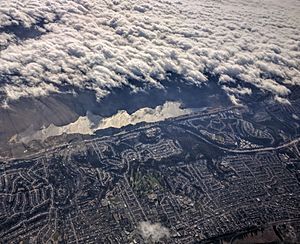San Andreas Creek facts for kids
Quick facts for kids San Andreas Creek |
|
|---|---|

San Andreas Creek's San Andreas Reservoir
|
|
| Other name(s) | San Andrés Creek, |
| Country | United States |
| State | California |
| Region | San Francisco Peninsula |
| County | San Mateo County |
| Physical characteristics | |
| Main source | East slope of Sweeney Ridge 918 ft (280 m) 37°37′01″N 122°27′29″W / 37.61694°N 122.45806°W |
| River mouth | Confluence with Lower Crystal Springs Reservoir (originally with San Mateo Creek) Pacifica, California 285 ft (87 m) 37°36′50″N 122°26′28″W / 37.61389°N 122.44111°W |
San Andreas Creek is a stream in San Mateo County, California. It flows for about 5.9 miles (9.5 km) through the area. This creek is special because it runs along the famous San Andreas Fault.
The creek starts on Sweeney Ridge. It then flows into and out of San Andreas Reservoir. After that, its water goes into Lower Crystal Springs Reservoir. Historically, it joined San Mateo Creek. Eventually, the water from San Andreas Creek reaches San Francisco Bay.
Contents
History of San Andreas Creek
Early Explorers and Naming
In 1769, a Spanish group led by Portolà discovered San Francisco Bay. They traveled down a valley that Portolà called Cañada de San Francisco. Today, we know this valley as San Andreas Creek. They camped near a lake called Laguna Grande, which is now covered by Upper Crystal Springs Reservoir.
Later, in 1774, another explorer named Padre Palóu renamed the valley. He called it Cañada de San Andrés on November 30. This date was the feast day of Saint Andrew, which is how the creek got its name.
In 1776, Juan Bautista de Anza also explored the area. He chose the spots for Mission San Francisco de Asís and the Presidio of San Francisco. He traveled back through the Cañada de San Andrés. He camped near San Mateo Creek.
The Spring Valley Lakes
The two Crystal Springs lakes and San Andreas Lake were once known as the Spring Valley Lakes. They were owned by a company called the Spring Valley Water Company. This company named the lakes after itself.
The original Spring Valley was a place in San Francisco. When the water company needed more water, it moved south. It brought the "Spring Valley" name with it to these lakes.
The San Andreas Watershed
Where the Creek Starts and Flows
The San Andreas Creek begins high up on the eastern slopes of Sweeney Ridge. Its source is about 900 feet (274 meters) above sea level. From there, it flows southeast. It follows the San Andreas Rift. This area is between Sweeney Ridge to the west and Buri Buri Ridge to the east.
The creek flows through San Andreas Reservoir. This reservoir was created in 1868 by building a 100-foot (30-meter) tall earth dam. The San Andreas Dam stops the creek's flow right below it. Water only flows out if there are spills, planned releases, or seepage.
Joining Other Waters
After leaving San Andreas Reservoir, the creek flows downhill. It then enters the northeast part of Lower Crystal Springs Reservoir. In the past, San Andreas Creek joined San Mateo Creek just before the current Crystal Springs Dam.
The town of Crystal Springs used to be where Lower Crystal Springs Reservoir is now. This town grew around a popular resort with the same name.
Ecology and Unique Plants
The Importance of Fog Drip
In the upper parts of the San Andreas Creek watershed, something called "fog drip" is very important. Fog drip happens when fog collects on trees and then drips to the ground like rain. This adds extra water to the area.
On Cahill Ridge, which is near the creek, scientists studied fog drip. They found that trees like tanoak, Coast redwood, and Douglas fir collect a lot of fog. One tanoak tree produced 59 inches (1500 mm) of water from fog drip in just five weeks! This was more than the total yearly rainfall in nearby grassy areas.
Special Plants in the Foggy Areas
The Douglas fir trees, which can be 125 feet (38 meters) tall, also collect fog. This creates very moist conditions. These conditions are perfect for some unique orchids.
- The giant helleborine (Epipactis gigantea)
- The phantom orchid (Cephalanthera austiniae)
These special plants were found only in these moist, foggy ridge tops. This shows how important the fog and the trees are to the local ecosystem.


